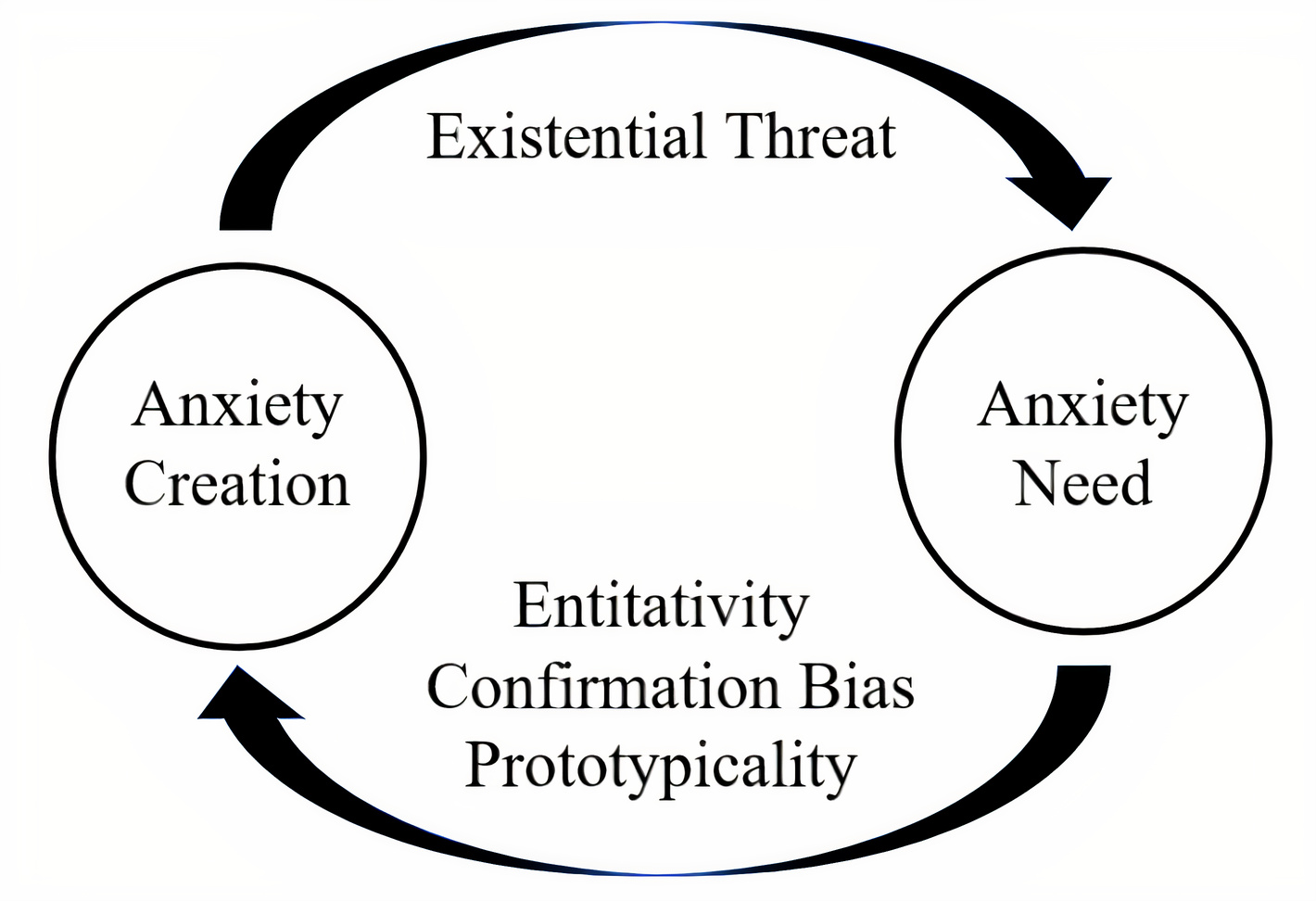by Jonathan Collins
This article summarises a recent paper published in European Journal on Criminal Policy and Research
The rise of harmful far-right narratives and the increasing reliance on social media platforms for socialising have created a fertile breeding ground for radical ideological movements and social divisions during the (and “post”) pandemic. However, there is still a lack of understanding regarding how these far-right online communities leveraged societal insecurities to attract followers, maintain engagement, and form a collective on social media platforms. In order to gain deeper insights into online far-right mobilisation, my research focused on examining UK-specific content, narratives, and prominent political figures on the fringe platform known as Gab. The article sheds light on the platform’s dissemination of hate-filled media and the toxic nature of its communication. Based on these findings, I propose a far-right mobilisation model called Collective Anxiety, which underscores the significance of toxic communication in sustaining and recruiting members within the community. These observations establish a precedent for the prevalence of hate-filled discourse on the platform and carry important policy implications that require attention.
Insecurity and Michael Hogg’s Uncertainty-Identity Theory
Michael Hogg’s uncertainty-identity theory provides a comprehensive argument and explanatory outline to help decipher the intragroup dynamics of far-right online mobilisation during COVID-19. Herein, Hogg unravels the complex paradigm between who we are and how we fit in society, focusing on uncertainty and self-actualisation. The main argument posits that, through group identity and reinforcement, individuals can remove their insecurity concerning negative or complex world phenomena, including but not limited to life crises, technological and social change, immigration, economic and socio-political turmoil, and pandemics. This group identification provides the individual with a sense of purpose, who they are, prototypical guidelines to follow, a value system, a simple dichotomy between “us” and “them”, and a basic understanding of world phenomena.
How does this relationship between group identity and reducing uncertainty relate to extremist mobilisation? According to Hogg, these successful practices depend on the following principles:
- Group-centralism and entitativity: A clear ideological foundation usually centred on ethnonationalism, xenophobia, or nativism.
- Confirmation bias and groupthink: The formation of echo chambers of similar ideologies work together to discredit external information, ensure continuity and homogeneity within group discourse, and reinforce preconceived understandings.
- Prototypicality and the importance of leaders: Leadership plays an essential role in the formation and maintenance of extremist groups.
- Existential threat: The self-construction of existential threats is used to purposefully challenge the group’s ideological certainties to create a common cause and produce violent mobilisation to protect their community.
Patterns of Toxic Communication on Gab: How Hate & Anxiety is an Effective Tool for Mobilisation
The application of Hogg’s uncertainty-identity theory, as depicted in the table below, reveals a complex interplay among these mechanisms. Though other scholars have highlighted the importance of the individual components and their effects on different extremist groups, I argue that it is in a combinational use which generates their effectiveness. Thus, predominant pairings between mechanisms help tell different stories of toxic communication styles on Gab. For instance, of the 575 posts connected to confirmation bias narratives, a massive 478 (83%) of these posts also mentioned one of the community’s existential threats. Other connections are more limited but essential, including pairing prototypicality with an existential threat (51%) and confirmation bias with entitativity (38%). For example, posts focusing on Muslims often present two narratives, one of out-group threat and the other an affirmation of a white victimhood worldview. Entitativity works with confirmation bias to cement in-group belonging, utilising discourse on truth to impose a self-righteous belief as protectors of the UK. Finally, prototypicality offers another tool to legitimise insecurity narratives, with predominant influencers advocating against the group’s existential threats. Subsequently, these couplings all work in tandem, as illustrated by Figure 1, with existential threat helping to establish and reinforce the group’s worldviews (confirmation bias), in-group belonging (entitativity), and prototypicality. However, the narrational process can both generate and structure societal insecurity. Herein, the community’s formulation of identity in these three latter mechanisms affects the threat corpus actively promoted on Gab. At the same time, confirmation bias, prototypicality, and group-centralism also interact with one another—on a more limited basis—to help reaffirm the user base’s collective self. Consequently, according to the findings, the UK-orientated community builds their mobilisation technique with these combinations, creating a cycle with two intermixing principles: the need for and creation of hate-filled content. Through demonstrating this connection, the work showcases the far-right’s need for different uncertainties to mobilise support, with these requirements necessitating the creation of toxic discourse directed against the outlined existential threats. The Collective Anxiety model helps explain this interdependent relationship and cycle.
Subsequently, these couplings all work in tandem, as illustrated by Figure 1, with existential threat helping to establish and reinforce the group’s worldviews (confirmation bias), in-group belonging (entitativity), and prototypicality. However, the narrational process can both generate and structure societal insecurity. Herein, the community’s formulation of identity in these three latter mechanisms affects the threat corpus actively promoted on Gab. At the same time, confirmation bias, prototypicality, and group-centralism also interact with one another—on a more limited basis—to help reaffirm the user base’s collective self. Consequently, according to the findings, the UK-orientated community builds their mobilisation technique with these combinations, creating a cycle with two intermixing principles: the need for and creation of hate-filled content. Through demonstrating this connection, the work showcases the far-right’s need for different uncertainties to mobilise support, with these requirements necessitating the creation of toxic discourse directed against the outlined existential threats. The Collective Anxiety model helps explain this interdependent relationship and cycle.
The article illustrates a model (see Figure 2) of online far-right mobilisation and the communities’ cyclical nature of harmful discourse. In order to create, promote, and maintain their community, the virtual collective establishes and manipulates common internal and external societal uncertainties. The community then exploits these anxieties and promotes membership and simple solutions (for example out-group scapegoats) to tackle the magnified problems. Thus, the insecurities and solutions connect individuals to a common set of grievances and an ontological belief system for overcoming them. Moreover, these two dynamics build on one another, with mobilisation dependent on creating and expanding a threat corpus within their hate-filled content milieu. Thus, Collective Anxiety is a cyclical and dichotomous relationship fuelling societal anxiety while providing answers and a sense of community to manage these uncertainties—an interdependent relationship between anxiety-creation and anxiety-need.
Conclusions: Where do we go from here?
Suppose we cannot consistently challenge, block, or remove toxic narratives on Gab. In that case, we must provide a different solution to tackle the indirect or deep-seated mechanisms behind the far-right’s narrational manipulation of existential threats. Providing a catch-all solution for those experiencing Collective Anxiety mobilisation is not easy. However, prevention is also not impossible. The article concludes with a call for building community resilience against online toxicity. Instead of resolving complex societal uncertainties, we can create a multimodal online landscape with the appropriate resources to resist far-right virtual mobilisation. Within this call, emerging studies suggest that constructing resilience online must focus on stimulating an alternative mode of collectivity which promotes community bridging, cultural identity, and trust. Uncertainty does not need to divide society; it can be a tool of collective unity, promoting wide-ranging, inclusive in-group values of mutual support. The targeted approach is bottom-up, meaning local civil society participation could reconcile polarising narratives (anxiety-creation) and missing in-group mechanisms for those experiencing insecurities (anxiety-need). Not only would this challenge the far-right’s Collective Anxiety framework and existential threat reliance, but it would also counteract the community’s other dependencies on prototypicality, entitativity, and confirmation bias. Therefore, by implementing novel strategies for online resilience, we can create an environment where toxicity can no longer serve as the source of far-right mobilisation.
To read more, the full article can be found here.
Jonathan Collins is a PhD candidate at the Department of Security Studies at Charles University, concentrating on the rise of the far-right as both an online social movement and threat for violent mobilisation.
Image Credit: Freepik


